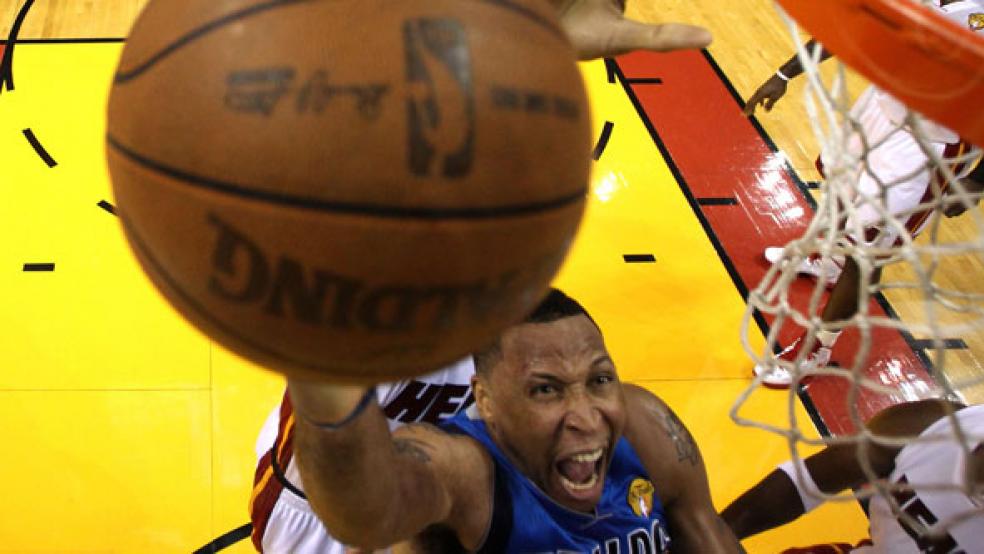Take LeBron James at his hoop-attacking best, Kobe Bryant at his most improvisational, and Kevin Durant at his most opportunistic – and then double all of that. Congratulations: You now have some sense of how hard both sides in the NBA’s labor dispute are working to spin their roles in an increasingly heated staring contest that has already cost the league the first two weeks of the NBA season.
On Thursday evening, NBA commissioner David Stern raised the prospect of even more canceled games – including the dark prospect of a basketball-free Christmas – if the two sides can’t come to an agreement during this Tuesday’s meeting with a federal labor mediator.
The NBA labor dispute has already led to the league’s first work stoppage since 1995. It could get worse. At the end of September, gambling website Bodog.com gave 5-to-4 odds that the entire NBA season would be canceled. Today, those are odds that all but the most optimistic NBA fan would bet, however unhappily. How did it come to this?
It starts with a problem that isn’t really a problem: It’s the enviable task of dividing up sky-high revenues between labor and ownership. During the 2010-11 season, the NBA saw a record $4.3 billion in net revenue. According to the terms of the NBA’s previous collective bargaining agreement, that basketball-related income – or BRI – was divided between the players and owners along a 57-43 split, with the players taking the greater share. It doesn’t sound like a bad deal. But the NBA had described it as one for years, and the league claimed that 22 of 30 teams lost money last season. Owners sought to reduce the players’ piece of the pie to 47 percent in the next agreement. The NBA Players Association offered to go down to 53 percent of BRI, a concession that NBA executive director Billy Hunter estimated at a cost of $1.1 billion over six years.
Owners have been unwilling to offer players more than a 50-50 split. Before a setback in negotiations last week, the difference between the players and owners was roughly $80 million, which is not exactly walking-around money for most people. But it’s next to nothing considering the original $1.6 billion in difference between the two sides’ positions. Given the bottom-line consequences of not getting a deal done, the costs to both sides would seem to outweigh almost any difference. (Al Moffatt, president and CEO of the advertising and marketing agency Worldwide Partners, predicted a “lost decade” if the league cancelled this season.)
Still there is no deal. There have been hints of compromise from both sides on salary caps and contract lengths. There have been intermittent pyrotechnics, including a heated exchange between Stern and Miami Heat star Dwyane Wade, who took issue with Stern’s finger-in-the-face conversational style. What there has not been, vexingly, is any palpable momentum towards an agreement.
The lockout is already having some palpable effects on the NBA’s economic landscape.
The Economic Risk of a Lost Season
With the season’s first two weeks going by the boards, teams will miss eight games’ worth of revenue – an amount estimated at $200 million. But the league isn’t the only entity that could lose out the longer the lockout lasts. It’s difficult to estimate the losses that would result from a season down the tubes, but they’d be painful. Marketing professor David Bojanic at University of Texas at San Antonio estimates that the San Antonio Spurs, for instance, contribute $95 million to the city’s economy. Losing even a tenth of that would be hard for local economies to absorb, especially in smaller NBA markets such as San Antonio, Oklahoma City and Sacramento.
For the hotels, bars and restaurants accustomed to doing pre- and post-game business, lost weeks of the season mean lost customers. For sporting goods stores stuck with racks of $80 jerseys, it means former bestsellers aren’t selling their best. And for thousands of people – from the 114 people laid off at NBA offices when the lockout began, to the thousands who earn a living selling tickets, hot dogs and other goods at NBA arenas – a longer lockout for players means a painful lockout from their jobs as well. (We haven’t even mentioned TV advertising revenue yet. The networks are likely to air college football and basketball in place of NBA games, if it comes to that.)
And thanks to the little-known “jock tax,” which allows states to tax visiting players – it forced LeBron James, for instance, to pay taxes for money earned in away games in California, Oregon and Oklahoma – some cash-strapped states will miss out on serious revenue. In 2006-07 alone, visiting athletes from four major sports paid the state of California $102 million in taxes.
So there’s a lot at stake when the two sides meet with a mediator next week. Robert Berliner, an attorney and mediator in Chicago, cautions that mediation is not a quick fix. But it could offer hope – something that months of contentious negotiation have failed to provide.
“The reality is that the players are young men, with skills that atrophy very quickly, and the cost of losing a season – while it’s a lot for the owners to absorb as well – is something the players can never get back,” says Berliner. “So the onus is on them to use the mediator to get a deal done and get back on the floor. Ultimately, these guys on both sides need each other.”
An entire economy, on and off the floor, depends upon them realizing that as soon as possible.



